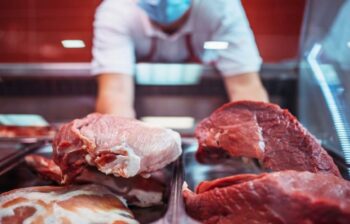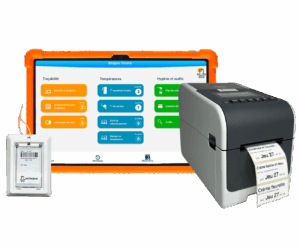Make Your HACCP Records in Butchery and Charcuterie Easily!
Comprendre l’HACCP
⏳ Temps de lecture : 6 min
? Mis à jour le : 07/10/2024
Contents
- How to implement the HACCP method in butchery and charcuterie?
- HACCP method in butchery and charcuterie: what are the obligations?
- Inspection of goods upon receipt in butchery and charcuterie
- Hygiene and handwashing of handlers
- The specific case of poultry: the bacterium Campylobacter
- Organizing display cases and refrigerators
How to implement the HACCP method in butchery and charcuterie? 🥩
Although there are many control requirements, they are simple to implement with good organization of your team’s work.
In this article, we focus on 4 important points. Other essential recommendations are also crucial to ensure safety and hygiene in your butchery and charcuterie.
You can consult the Butchery GBPH and the Charcuterie GBPH as reference documents on good hygiene practices in your profession.
HACCP Method in Butchery and Charcuterie: What Are the Obligations? ⚖️
Like all food professions, you have a traceability obligation, a requirement to respect expiration dates, a guarantee of the cold chain, and the follow-up of a cleaning plan, etc. 🧼 But certain safety points are reinforced during handling.
Inspection of Goods Upon Receipt in Butchery and Charcuterie
Cleanliness of Delivery and Goods
To limit the risk of contamination of the goods entering your premises, check the cleanliness of the truck, equipment, and the delivery person’s attire. Also verify proper separation of products between carcasses, poultry, and other items.
Cold Chain Compliance
If you receive goods ❄️ from a distributor, you must ensure that the temperature complies with regulations:
- Carcasses: temperature less than or equal to 7 °C
- Cut meats and charcuterie: temperature less than or equal to 4 °C
- Special case for minced meat: temperature less than or equal to 2 °C
Frozen meat must be kept at a maximum of -18 °C (or -12 °C according to the GBPH).
During delivery, you must check the truck temperature with a thermometer. Ideally, use a laser thermometer to take the temperature of the truck and a few products at their core (one per category).
If you pick up your goods from a wholesaler or the M.I.N., the same cold chain guarantee rules apply: you must transport your products using a vehicle equipped to maintain the temperature at a maximum of 7 °C for carcasses, 4 °C for meats and charcuterie, and 2 °C for minced meat.
Traceability and Labeling
You must keep all your traceability labels, without exception. Whether they are labels from your carcasses or from your finished products delivered vacuum-packed or frozen.
To guarantee the traceability of your meats, you must keep information that allows identification of the animal (ear tag, slaughter number, traceability label, etc.).
The slaughterhouse stamps the carcass and cut pieces with a slaughter number. This number must be present on your invoices to ensure traceability. Labels containing batch number, meat origin, expiration date for processed products, etc., must also be kept. You can either store them in a traceability logbook or photograph them with the Octopus HACCP mobile app, which automatically organizes and archives them.
During inspections by veterinary services, they will check that you properly keep this information. Traceability in butchery and charcuterie is a critical control point. You have an obligation of results regarding traceability, not of means. This means it is not necessary to keep paper labels; a photo is sufficient. Make sure the photographed information is clear and complete.
When you process your carcasses in a cutting workshop or produce your famous paupiettes that make your reputation in your processing laboratory, you must create a batch number that will allow you to identify the different ingredients used in your recipe. This information must also be kept.
Hygiene and Handwashing of Handlers
Handling food products can be a significant source of contamination. It is essential that your teams are trained to follow hygiene rules during the different stages of handling.
Clothing
Teams must have complete, clean professional uniforms, regularly replaced, provided in a locker room (room or closet). They should store their street clothes and personal belongings there. 🧥
Handwashing
Nails must be clean and short. In case of wounds, they must be disinfected and protected. 🩹
Handwashing must be performed between each contaminating action:
- Before and during work
- After any contaminating operation (e.g., handling poultry, eggs, etc.)
- Before handling sensitive products (mincing, slicing, etc.)
There must be a sufficient number of water points 🚰 equipped with liquid soap, nail brushes, disposable towels (single use, no cloth towels), and a bin to discard the paper.
Cleaning and Disinfection of Premises and Equipment
For the premises, establish a cleaning and disinfection plan compliant with regulations. You can create your cleaning and disinfection plan using our cleaning plan guide and download PDF and Excel tables.
For equipment, be especially vigilant with mincers and slicers, ensuring they are in good condition, easily disassembled, and rigorously and regularly cleaned and disinfected. ⚙️
The NF-HA (French Food Hygiene Standard) and NF-HSA (Hygiene, Safety, Suitability for Use) standards ensure equipment is food-appropriate, made with compliant materials, and easy to clean, etc.
The Specific Case of Poultry: The Bacterium Campylobacter 🐔
Poultry carries the bacterium Campylobacter. This bacterium is the number one cause of acute foodborne gastroenteritis. Campylobacter develops in the digestive tract of poultry as well as other farmed or wild animals, which are healthy carriers. 🦃
In humans, it can cause many serious illnesses, especially in vulnerable groups (young children, frail elderly people).
Campylobacter is destroyed by heat when cooked above 63 °C. The main risk in butchery and charcuterie lies in cross-contamination between raw contaminated poultry meat and other meats, which may not be cooked.
- Make sure to store poultry separately from other types of meat
- Handle poultry at the end of your preparation cycle and/or systematically disinfect equipment that has come into contact with raw poultry
- Wash your hands thoroughly after each handling of raw poultry
Sources:
Que Choisir
Santé publique France
Organizing Display Cases and Refrigerators
The FIFO Rule
First In, First Out (FIFO).
Food separation
‘1. All raw materials, ingredients, intermediate products, and finished products must be stored, packaged, displayed, and handed over to the consumer under conditions that prevent any deterioration or contamination likely to make them unfit for human consumption or dangerous to health. In particular, the storage of food directly on the floor and the presence of pets are prohibited in premises where activities are carried out.
2. All necessary precautions must be taken to ensure that unprotected food on display is protected from contamination that may result from the proximity of the consumer or handling by the consumer.’

This information is indicative and extracted from the Butchery GBPH. If you want to learn more, we recommend contacting authorized training organizations to establish a Sanitary Control Plan adapted to your activity and to regularly train in good hygiene practices.
Download Our Guides and Tables for Free 📥
Discover below our new comprehensive HACCP guide, specially for Butchery and Charcuterie. It includes:
- 1 complete HACCP guide,
- 3 PDF tables for your records,
- 1 Excel sheet to create your cleaning plan,
- 1 training sheet for your teams.





